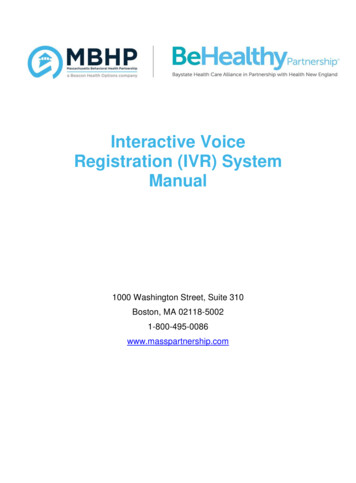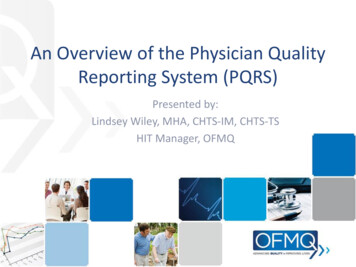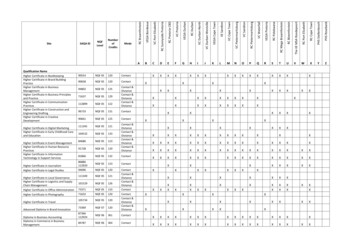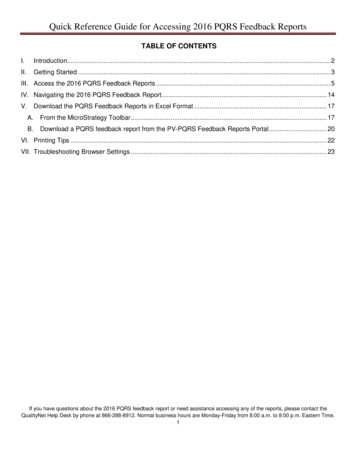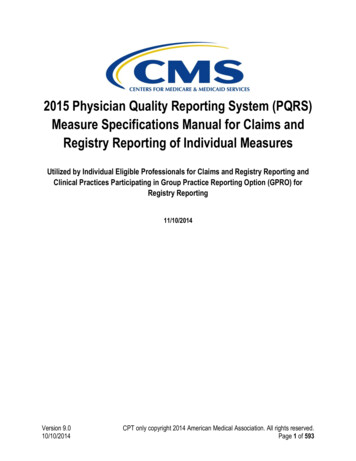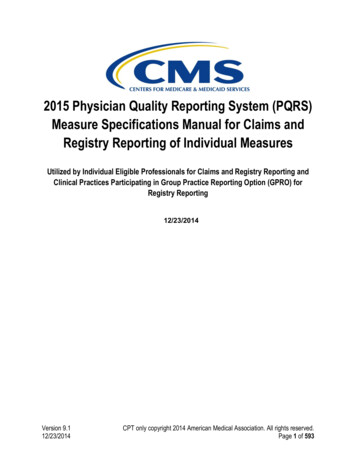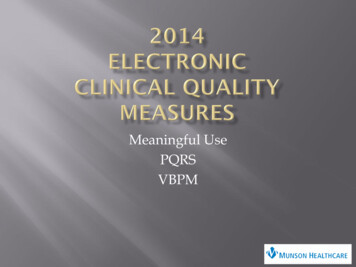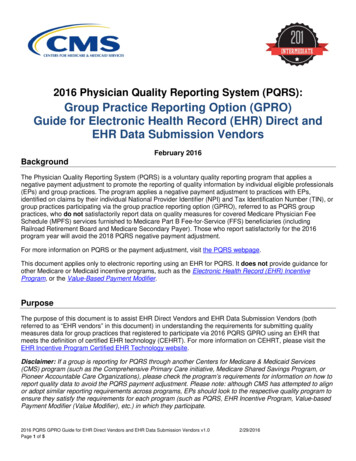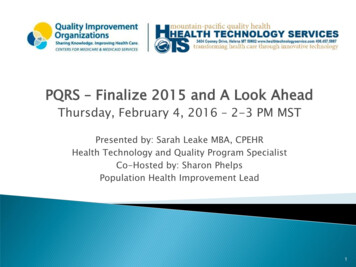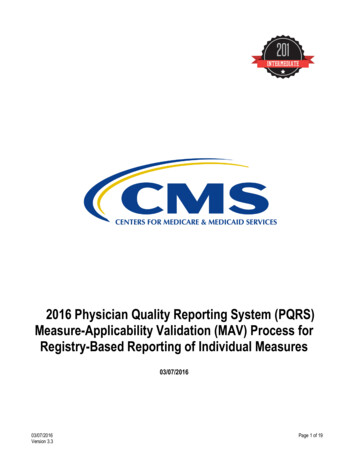
Transcription
Measure #12 (NQF 0086): Primary Open-Angle Glaucoma (POAG): Optic Nerve Evaluation – NationalQuality Strategy Domain: Effective Clinical Care2016 PQRS OPTIONS FOR INDIVIDUAL MEASURES:CLAIMS, REGISTRYDESCRIPTION:Percentage of patients aged 18 years and older with a diagnosis of primary open-angle glaucoma (POAG) who havean optic nerve head evaluation during one or more office visits within 12 monthsINSTRUCTIONS:This measure is to be reported a minimum of once per reporting period for patients seen during the reportingperiod. It is anticipated that clinicians who provide the primary management of patients with primary open-angleglaucoma (in either one or both eyes) will submit this measure.Measure Reporting via Claims:ICD-10-CM diagnosis codes, CPT codes, and patient demographics are used to identify patients who are included inthe measure’s denominator. CPT Category II codes are used to report the numerator of the measure.When reporting the measure via claims, submit the listed ICD-10-CM diagnosis codes, CPT codes, and theappropriate CPT Category II code OR the CPT Category II code with the modifier. The modifiers allowed for thismeasure are: 1P- medical reasons, 8P- reason not otherwise specified. All measure-specific coding should bereported on the claim(s) representing the eligible encounter.Measure Reporting via Registry:ICD-10-CM diagnosis codes, CPT codes, and patient demographics are used to identify patients who are included inthe measure’s denominator. The listed numerator options are used to report the numerator of the measure.The quality-data codes listed do not need to be submitted for registry-based submissions; however, these codes maybe submitted for those registries that utilize claims data.DENOMINATOR:All patients aged 18 years and older with a diagnosis of POAGDenominator Criteria (Eligible Cases):Patients aged 18 years on date of encounterANDDiagnosis for primary open-angle glaucoma (ICD-10-CM): H40.10X0, H40.10X1, H40.10X2, H40.10X3,H40.10X4, H40.11X0, H40.11X1, H40.11X2, H40.11X3, H40.11X4, H40.1210, H40.1211, H40.1212,H40.1213, H40.1214, H40.1220, H40.1221, H40.1222, H40.1223, H40.1224, H40.1230, H40.1231,H40.1232, H40.1233, H40.1234, H40.1290, H40.1291, H40.1292, H40.1293, H40.1294, H40.151, H40.152,H40.153, H40.159ANDPatient encounter during the reporting period (CPT): 92002, 92004, 92012, 92014, 99201, 99202,99203, 99204, 99205, 99212, 99213, 99214, 99215, 99304, 99305, 99306, 99307, 99308, 99309, 99310,99324, 99325, 99326, 99327, 99328, 99334, 99335, 99336, 99337NUMERATOR:Patients who have an optic nerve head evaluation during one or more office visits within 12 monthsNumerator Quality-Data Coding Options for Reporting Satisfactorily:Optic Nerve Head Evaluation PerformedVersion 10.011/17/2015CPT only copyright 2015 American Medical Association. All rights reserved.Page 1 of 6
Performance Met: CPT II 2027F:OROptic nerve head evaluation performedOptic Nerve Head Evaluation not Performed for Medical ReasonsAppend a modifier (1P) to CPT Category II code 2027F to report documented circumstances thatappropriately exclude patients from the denominator.Medical Performance Exclusion: 2027F with 1P: Documentation of medical reason(s) for not performingan optic nerve head evaluationOROptic Nerve Head Evaluation not Performed, Reason not Otherwise SpecifiedAppend a reporting modifier (8P) to CPT Category II code 2027F to report circumstances when the actiondescribed in the numerator is not performed and the reason is not otherwise specified.Performance Not Met: 2027F with 8P:Optic nerve head evaluation was not performed, reasonnot otherwise specifiedRATIONALE:Changes in the optic nerve are one of two characteristics which currently define progression and thus worsening ofglaucoma disease status (the other characteristic is visual field). There is a significant gap in documentation patternsof the optic nerve for both initial and follow-up care (Fremont, 2003), even among specialists (Lee, 2006).Examination of the optic nerve head and retinal nerve fiber layer provides valuable structural information aboutglaucomatous optic nerve damage. Visible structural alterations of the optic nerve head or retinal nerve fiber layerand development of peripapillary choroidal atrophy frequently occur before visual field defects can be detected.Careful study of the optic disc neural rim for small hemorrhages is important, since these hemorrhages can precedevisual field loss and further optic nerve damage.CLINICAL RECOMMENDATION STATEMENTS:Ophthalmic EvaluationIn completing the elements in the comprehensive adult medical eye evaluation, the ophthalmic evaluation specificallyfocuses on the following elements: History [A:III]Visual acuity measurement [A:III]Pupil examination [B:II]Anterior segment examination [A:III]Intraocular pressure measurement [A:I]Gonioscopy [A:III]Optic nerve head and retinal nerve fiber layer examination [A:III]Fundus examination [A:III](AAO, 2010)COPYRIGHT:Physician Performance Measures (Measures) and related data specifications, developed by the American MedicalAssociation (AMA)-convened Physician Consortium for Performance Improvement (PCPI ) and the NationalCommittee for Quality Assurance (NCQA) pursuant to government sponsorship under subcontract 6205-05-054 withMathematica Policy Research, Inc. under contract 500-00-0033 with Centers for Medicare & Medicaid Services.These performance Measures are not clinical guidelines and do not establish a standard of medical care, and havenot been tested for all potential applications.The Measures, while copyrighted, can be reproduced and distributed, without modification, for noncommercialpurposes, eg, use by health care providers in connection with their practices. Commercial use is defined as the sale,Version 10.011/17/2015CPT only copyright 2015 American Medical Association. All rights reserved.Page 2 of 6
license, or distribution of the Measures for commercial gain, or incorporation of the Measures into a product orservice that is sold, licensed or distributed for commercial gain. Commercial uses of the Measures require a licenseagreement between the user and the AMA, (on behalf of the PCPI) or NCQA. Neither the AMA, NCQA, PCPI nor itsmembers shall be responsible for any use of the Measures.THE MEASURES AND SPECIFICATIONS ARE PROVIDED “AS IS” WITHOUT WARRANTY OF ANY KIND. 2004-6 American Medical Association and National Committee for Quality Assurance. All Rights Reserved.Limited proprietary coding is contained in the Measure specifications for convenience. Users of the proprietary codesets should obtain all necessary licenses from the owners of these code sets. The AMA, NCQA, the PCPI and itsmembers disclaim all liability for use or accuracy of any Current Procedural Terminology (CPT ) or other codingcontained in the specifications.CPT contained in the Measures specifications is copyright 2004-2015 American Medical Association. G codes andassociated descriptions included in these Measure specifications are in the public domain.LOINC copyright 2004-2015 Regenstrief Institute, Inc. SNOMED CLINICAL TERMS (SNOMED CT ) copyright2004-2015 International Health Terminology Standards Development Organization. All Rights Reserved. Use ofSNOMED CT is only authorized within the United States.Version 10.011/17/2015CPT only copyright 2015 American Medical Association. All rights reserved.Page 3 of 6
Version 10.011/17/2015CPT only copyright 2015 American Medical Association. All rights reserved.Page 4 of 6
2016 Claims/Registry Individual Measure FlowPQRS #12 NQF #0086: Primary Open-Angle Glaucoma (POAG): Optic Nerve EvaluationPlease refer to the specific section of the Measure Specification to identify the denominator and numerator informationfor use in reporting this Individual Measure.1. Start with Denominator2. Check Patient Age:a. If the Age is greater than or equal to 18 years of age on Date of Service and equals No during themeasurement period, do not include in Eligible Patient Population. Stop Processing.b. If the Age is greater than or equal to 18 years of age on Date of Service and equals Yes during themeasurement period, proceed to check Patient Diagnosis.3. Check Patient Diagnosis:a. If Diagnosis of POAG as Listed in the Denominator equals No, do not include in Eligible PatientPopulation. Stop Processing.b. If Diagnosis of POAG as Listed in the Denominator equals Yes, proceed to check Encounter Performed.4. Check Encounter Performed:a. If Encounter as Listed in the Denominator equals No, do not include in Eligible Patient Population. StopProcessing.b. If Encounter as Listed in the Denominator equals Yes, include in the Eligible population.5. Denominator Population:a. Denominator population is all Eligible Patients in the denominator. Denominator is represented asDenominator in the Sample Calculation listed at the end of this document. Letter d equals 8 patients inthe sample calculation.6. Start Numerator7. Check was Optic Nerve Head Evaluation Performed:a. If Optic Nerve Head Evaluation Performed equals Yes, include in Reporting Met and Performance Met.b. Reporting Met and Performance Met letter is represented in the Reporting Rate and Performance Rate inthe Sample Calculation listed at the end of this document. Letter a equals 4 patients in SampleCalculation.c. If Optic Nerve Head Evaluation Performed equals No, proceed to Documentation of Medical Reason(s)for Not Performing Optic Nerve Head Evaluation.8. Check Documentation of Medical Reason(s) for Not Performing Optic Nerve Head Evaluation:a. If Documentation of Medical Reason(s) for Not Performing Optic Nerve Head Evaluation equals Yes,include in Reporting Met and Performance Exclusion.Version 10.011/17/2015CPT only copyright 2015 American Medical Association. All rights reserved.Page 5 of 6
b. Reporting Met and Performance Exclusion letter is represented in the Reporting Rate and PerformanceRate in the Sample Calculation listed at the end of this document. Letter b equals 1 patient in the SampleCalculation.c. If Documentation of Medical Reason(s) for Not Performing Optic Nerve Head Evaluation equals No,proceed to Optic Nerve Head Evaluation Not Performed, Reason Not Specified.9. Check Optic Nerve Head Evaluation Not Performed, Reason Not Specified:a. If Optic Nerve Head Evaluation Not Performed, Reason Not Specified equals Yes, include in ReportingMet and Performance Not Met.b. Reporting Met and Performance Not Met letter is represented in the Reporting Rate in the SampleCalculation listed at the end of this document. Letter c equals 2 patients in the Sample Calculation.c. If Optic Nerve Head Evaluation Not Performed, Reason Not Specified equals No, proceed to CheckReporting Not Met.10. Check Reporting Not Met:a. If Reporting Not Met, the Quality Data Code or equivalent was not reported. 1 patient has beensubtracted from the reporting numerator in sample calculation.Version 10.011/17/2015CPT only copyright 2015 American Medical Association. All rights reserved.Page 6 of 6
Measure Reporting via Claims: ICD-10-CM diagnosis codes, CPT codes, and patient demographics are used to identify patients who are included in the measure's denominator. CPT Category II codes are used to report the numerator of the measure. When reporting the measure via claims, submit the listed ICD-10-CM diagnosis codes, CPT codes, and the
